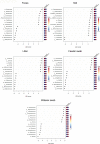Uncovering changes in microbiome profiles across commercial and backyard poultry farming systems
- PMID: 37607066
- PMCID: PMC10580917
- DOI: 10.1128/spectrum.01682-23
Uncovering changes in microbiome profiles across commercial and backyard poultry farming systems
Abstract
The microbiome profiles of poultry production systems significantly impact bird health, welfare, and the environment. This study investigated the influence of broiler-rearing systems on the microbiome composition of commercial and backyard chicken farms and their environment over time. Understanding these effects is vital for optimizing animal growth, enhancing welfare, and addressing human and environmental health implications. We collected and analyzed various samples from commercial and backyard farms, revealing significant differences in microbial diversity measurements between the two systems. Backyard farms exhibited higher alpha diversity measurements in soil and water samples, while commercial farms showed higher values for litter and feeder samples. The differences in microbial diversity were also reflected in the relative abundance of various microbial taxa. In backyard farms, Proteobacteria levels increased over time, while Firmicutes levels decreased. Campilobacterota, including the major poultry foodborne pathogen Campylobacter, increased over time in commercial farm environments. Furthermore, Bacteroides, associated with improved growth performance in chickens, were more abundant in backyard farms. Conversely, pathogenic Acinetobacter was significantly higher in backyard chicken fecal and feeder swab samples. The presence of Brevibacterium and Brachybacterium, associated with low-performing broiler flocks, was significantly higher in commercial farm samples. The observed differences in microbial composition and diversity suggest that farm management practices and environmental conditions significantly affect poultry health and welfare and have potential implications for human and environmental health. Understanding these relationships can inform targeted interventions to optimize poultry production, improve animal welfare, and mitigate foodborne pathogens and antimicrobial resistance risks. IMPORTANCE The microbiome of poultry production systems has garnered significant attention due to its implications on bird health, welfare, and overall performance. The present study investigates the impact of different broiler-rearing systems, namely, commercial (conventional) and backyard (non-conventional), on the microbiome profiles of chickens and their environment over time. Understanding the influence of these systems on microbiome composition is a critical aspect of the One-Health concept, which emphasizes the interconnectedness of animal, human, and environmental health. Our findings demonstrate that the type of broiler production system significantly affects both the birds and their environment, with distinct microbial communities associated with each system. This study reveals the presence of specific microbial taxa that differ in abundance between commercial and backyard poultry farms, providing valuable insights into the management practices that may alter the microbiome in these settings. Furthermore, the dynamic changes in microbial composition over time observed in our study highlight the complex interplay between the poultry gut microbiome, environmental factors, and production systems. By identifying the key microbial players and their fluctuations in commercial and backyard broiler production systems, this research offers a foundation for developing targeted strategies to optimize bird health and welfare while minimizing the potential risks to human and environmental health. The results contribute to a growing body of knowledge in the field of poultry microbiome research and have the potential to guide future improvements in poultry production practices that promote a sustainable and healthy balance between the birds, their environment, and the microbial communities they host.
Keywords: broiler farming; marker taxa; poultry microbiome; relative abundance; temporal changes.
Conflict of interest statement
The authors declare no conflict of interest.
Figures




Similar articles
-
Fluoroquinolone-resistant Campylobacter in backyard and commercial broiler production systems in the United States.JAC Antimicrob Resist. 2024 Jul 6;6(4):dlae102. doi: 10.1093/jacamr/dlae102. eCollection 2024 Aug. JAC Antimicrob Resist. 2024. PMID: 38974944 Free PMC article.
-
Megaplasmid Dissemination in Multidrug-Resistant Salmonella Serotypes from Backyard and Commercial Broiler Production Systems in the Southeastern United States.Foodborne Pathog Dis. 2025 May;22(5):322-331. doi: 10.1089/fpd.2023.0181. Epub 2024 Apr 18. Foodborne Pathog Dis. 2025. PMID: 38635963
-
Fecal microbiota landscape of commercial poultry farms in Faisalabad, Pakistan: A 16S rRNA gene-based metagenomics study.Poult Sci. 2025 Jun;104(6):105089. doi: 10.1016/j.psj.2025.105089. Epub 2025 Mar 23. Poult Sci. 2025. PMID: 40187012 Free PMC article.
-
Backyard poultry: exploring non-intensive production systems.Poult Sci. 2024 Feb;103(2):103284. doi: 10.1016/j.psj.2023.103284. Epub 2023 Nov 17. Poult Sci. 2024. PMID: 38056053 Free PMC article. Review.
-
Relationship of the Poultry Microbiome to Pathogen Colonization, Farm Management, Poultry Production, and Foodborne Illness Risk Assessment.J Food Prot. 2023 Nov;86(11):100169. doi: 10.1016/j.jfp.2023.100169. Epub 2023 Sep 27. J Food Prot. 2023. PMID: 37774838 Review.
Cited by
-
Exploring Pathogen Presence Prediction in Pastured Poultry Farms through Transformer-Based Models and Attention Mechanism Explainability.Microorganisms. 2024 Jun 23;12(7):1274. doi: 10.3390/microorganisms12071274. Microorganisms. 2024. PMID: 39065042 Free PMC article.
-
Improving broiler health through cecal microbiota transplantation: a comprehensive study on growth, immunity, and microbial diversity.J Anim Sci. 2024 Jan 3;102:skae131. doi: 10.1093/jas/skae131. J Anim Sci. 2024. PMID: 38720654 Free PMC article.
-
16S amplicon-based microbiome biomapping of a commercial broiler hatchery.Anim Microbiome. 2024 Aug 9;6(1):46. doi: 10.1186/s42523-024-00334-3. Anim Microbiome. 2024. PMID: 39123264 Free PMC article.
-
Impact of live black soldier fly larvae supplementation on laying hen performance, stress levels and excreta microbiota.Poult Sci. 2025 Sep;104(9):105418. doi: 10.1016/j.psj.2025.105418. Epub 2025 Jun 10. Poult Sci. 2025. PMID: 40554154 Free PMC article.
-
Fluoroquinolone-resistant Campylobacter in backyard and commercial broiler production systems in the United States.JAC Antimicrob Resist. 2024 Jul 6;6(4):dlae102. doi: 10.1093/jacamr/dlae102. eCollection 2024 Aug. JAC Antimicrob Resist. 2024. PMID: 38974944 Free PMC article.
References
LinkOut - more resources
Full Text Sources

